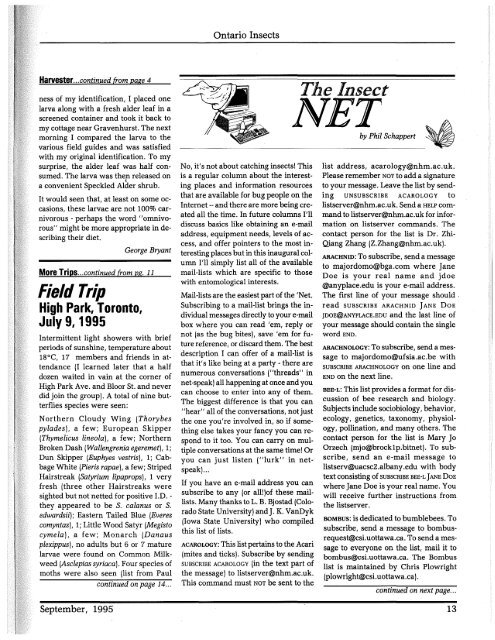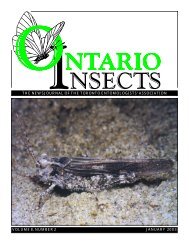1995 - Toronto Entomologists' Association
1995 - Toronto Entomologists' Association
1995 - Toronto Entomologists' Association
Create successful ePaper yourself
Turn your PDF publications into a flip-book with our unique Google optimized e-Paper software.
Ontario InsectsHarvester...continued from page 4ness of my identification, I placed onelarva along with a fresh alder leaf in ascreened container and took it back tomy cottage near Gravenhurst. The nextmorning I compared the larva to thevarious field guides and was satisfiedwith my original identification. To mysurprise, the alder leaf was half consumed.The larva was then , released ona convenient Speckled Alder shrub.It would seen that, at least on some occasions,these larvae are not 100% carnivorous- perhaps the word "omnivorous"might be more appropriate in describingtheir diet.George BryantMore Trips...continued from pg. 11Field TripHigh Park, <strong>Toronto</strong>,July 9, <strong>1995</strong>Intermittent light showers with briefperiods of sunshine, temperature about18°C, 17 members and friends in attendance(I learned later that a halfdozen waited in vain at the corner ofHigh Park Ave. and Bloor St. and neverdid join the group). A total of nine butterfliesspecies were seen:Northern Cloudy Wing (Thorybespylades) , a few; European Skipper(Thymelicus lineola), a few; NorthernBroken Dash (Wallengrenia egeremet), 1;Dun Skipper (Euphyes vestris), 1; CabbageWhite (pieris rapae), a few; StripedHairstreak (Satyrium lipaprops), 1 veryfresh (three other Hairstreaks weresighted but not netted for positive J.D. they appeared to be S. calanus or S.edwardsii); Eastern Tailed Blue (Everescomyntas), 1; Little Wood Satyr (Megistocymela), a few; Monarch (Danausplexippus) , no adults but 6 or 7 maturelarvae were found on Common Milkweed(Asclepias syriaca). Four species ofmoths were also seen (list from Paulcontinued on page 14...September, <strong>1995</strong>No, it's not about catching insects! Thisis a regular column about the interestingplaces and information resourcesthat are available for bug people on theInternet -- and there are more being createdall the time. In future columns I'lldiscuss basics like obtaining an e-mailaddress, equipment needs, levels of access,and offer pointers to the most interestingplaces but in this inaugural columnI'll simply list all of the availablemail-lists which are specific to thosewith entomological interests.Mail-lists are the easiest part of the 'Net.Subscribing to a mail-list brings the individualmessages directly to your e-mailbox where you can read 'em, reply ornot (as the bug bites), save 'em for futurereference, or discard them. The bestdescription I can offer of a mail-list isthat it's like being at a party - there arenumerous conversations ("threads" innet-speak) all happening at once and youcan choose to enter into any of them.The biggest difference is that you can"hear" all of the conversations, notjustthe one you're involved in, so if somethingelse takes your fancy you can respondto it too. You can carry on multipleconversations at the same time! Oryou can just listen ("lurk" in netspeak)...If you have an e-mail address you cansubscribe to any (or al1!)of these maillists.Many thanks to L. B. Bjostad (ColoradoState University) andJ. K. VanDyk(Iowa State University) who compiledthis list of lists.ACAROLOGY: This list pertains to the Acari(mites and ticks). Subscribe by sendingSUBSCRIBE ACAROLOGY (in the text part ofthe message) to listserver@nhm.ac.uk.This command must NOT be sent to theThe InsectNETby Phil Schappert----------------------------~list address, acarology@nhm.ac.uk.Please remember NOT to add a signatureto your message. Leave the list by sendingUNSUBSCRIBE ACAROLOGY tolistserver@nhm.ac.uk. Send a HELP commandto listserver@nhm.ac.uk for informationon listserver commands. Thecontact person for the list is Dr. ZhiQiang Zhang (Z.Zhang@nhm.ac.ukl.ARACHNID: To subscribe, send a messageto majordomo@bga.com where JaneDoe is your real name and jdoe@anyplace.edu is your e-mail address.The first line of your message should .read SUBSCRIBE ARACHNID JANE DOEJDOE@ANYPLACE.EDU and the last line ofyour message should contain the singleword END.ARACHNOLOGY: To subscribe, send a messageto majordomo@ufsia.ac.be withSUBSCRIBE ARACHNOLOGY on one line andEND on the next line.BEE-L: This list provides a format for discussionof bee research and biology.Subjects include sociobiology, behavior,ecology, genetics, taxonomy, physiology,pollination, and many others. Thecontact person for the list is Mary JoOrzech (mjo@brock1p.bitnet). To subscribe,send an e-mail message tolistserv@uacscZ.albany.edu with bodytext consisting of SUBSCRIBE BEE-L JANE DOEwhere Jane Doe is your real name. Youwill receive further instructions fromthe listserver.BOMBUS: is dedicated to bumblebees. Tosubscribe, send a message to bombusrequest@csLuottawa.ca.To send a messageto everyone on the list, mail it tobombus@csLuottawa.ca. The Bombuslist is maintained by Chris Plowright(plowright@csLuottawa.ca).continued on next page...13



